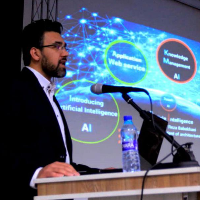The machine learning process in applying spatial relations of residential plans based on samples and adjacency matrix
The current world is moving towards the development of hardware or software presence of artificial intelligence in all fields of human work, and architecture is no exception. Now this research seeks to present a theoretical and practical model of intuitive design intelligence that shows the problem of learning layout and spatial relationships to artificial intelligence algorithms; Therefore, the question of this research is to present a theoretical and practical model through the integration of computational methods for machine learning to apply spatial relationships in residential plans based on architectural criteria and standards. The problem of this research is to find the precise methods and techniques of applying spatial relationships to architectural plans through artificial intelligence algorithms based on architectural criteria, which should be applied by automatic design intelligence in machine perception and then in the design process. Also, the hypothesis of the research shows that to achieve this, it is necessary to use adjacency matrices, calculation formulas, and various algorithms for the perception and production of spatial relationships; Therefore, the research method is explanatory research to examine and transfer complex ideas and information based on data collection, including library studies, documents, educational samples, calculations, and mathematical formulas. The explanatory method seeks to present new knowledge, describe a process, or develop a concept. As the results of the research show, instead of randomly starting plan generation through evolutionary algorithms, spatial relations in architectural plans can be done faster and more accurately by combining adjacency matrices, and computational formulas with evolutionary algorithms.
-
Explaining the Model for Promoting the Position of Professors in Contemporary Architecture Education Case Study (Selected Universities in Iran and Giliçim University, Istanbul, Türkiye)
Hassan Torabi, Razieh Labibzadeh *,
Journal of Studies of Behavior and Environment in Architecture, Spring 2025 -
Conceptual Modeling Of Evidence-Based Quality Improvement In Public Hospitals (EBD) With A Patient Satisfaction Approach (Case Study: Gandhi Hospital, Tehran)
Aida Sadeghi, *, Khosrow Daneshjoo, Seyed Behshid Hosseini
Journal of Studies of Behavior and Environment in Architecture, Spring 2025 -
A Comparative Study of Conventional Architectural Design Methods and Adolescent Personality Types based on MBTI Components
Zeinab Moghaddas, Azadeh Shahcheragi *,
Karafan, Winter 2025 -
Automated design and drawing of architectural plans by combining evolutionary algorithms, machine learning and sample-based
*, , Hossibn Zabihi
Maremat & memari-e Iran, -
Automated Floor Plan Generation by a Combination of Evolutionary Algorithm (Genetics) and Machine Learning (K-Nearest Neighbors and K-Means Clustering)
*, Mahsa Safarnejad
International Journal of Architectural Engineering & Urban Planning, Oct 2024 -
Explanation of the educational model of architecture based on human in the professor's position (Case Study: students of South Tehran University)
Hassan Torabi, Razieh Labibzadeh *,
Journal of Architecture and urbanism, Spring 2024




